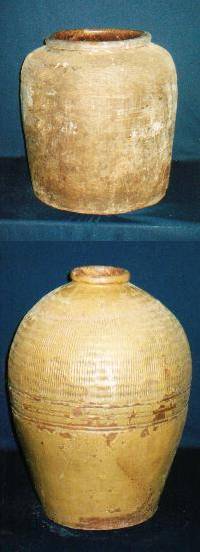
This page is only one of many thousands of Gotheborg.com Help and Information Pages, offering specialized knowledge on Chinese and Japanese Porcelain, including a Glossary, Q&A, Chinese and Japanese Porcelain Marks, Chinese Porcelain Exhibition and Excavation reports etc. For personal help and far more information, join our Discussion Board or use 'Ask a Question' for quick email consultations. For full text and better navigation, use a full-screen device rather than a mobile phone, that offers only limited content.
 We bought these jars from a "treasure hunter" who told us they had found them in the sea. They are heavy and with thick walls.
We bought these jars from a "treasure hunter" who told us they had found them in the sea. They are heavy and with thick walls.
In the book by He Li, Chinese Ceramic - The New Standard Guide I have found some pictures very similar to these pieces, but they seems to be from the "Neolithic" Period.
Any comments?
One of the most important areas of production for this kind of pottery was in the Canton area but I would find it quite likely that most merchants - trading from the ports along the South China Sea from Korea/Japan down along the Fujian coast, around the Malaysian peninsula and up along the east side of the Bay of Bengal and all the way around the Arabian Sea - had their storage jars made locally whenever possibly.
Many other important ports had a ceramic industry near by, like Hangchow, Swatow, Amoy and Martaban in former British Burma (today Myanmar). This place "Martaban" are also historically the most important, connected as it is specifically to large storage jars who have their name after this port.
Most of these trade or storage jars are difficult to identify as to their place of production and still more hard to put a date on, since they have few features which separates one from another.
Most do seems to have been made during the last 500 years and the majority seems to have been made during the course of the 19th century.
Jan-Erik Nilsson
Selamat Petang. These pieces cannot be Neolithic for a number of facts. One is that you indicated that there were recovered from a ship wreck. It's generally reguarded that regular ceramic trade between China and South East Asia started during the Song dynasty.
However it is also known that trade occured much earlier than that but on an inregular basis. Proof of this are wares from the Han and Warring States periods sometimes recovered and dug up from the ground by farmers or other means. However I doubt that such trade occured during the Neolithic periods.
Personally I think the pieces are 19th century. I'm pretty sure the first jar with the patterns on the upper area is 19th century. It is actually an earlier salted duck egg pot. Actually I found just such a pot half buried in thick moss at the back of an old house my brother had just purchased. Most likely exported from South China. Modern duck egg pots tend to be a little taller and more slender, lack the patterns and are usually covered with a dark brown glaze.
I'm also familier with the second larger wider jar. Such pieces have been made from the Late Ming all the way to 19th century with varied glazes. I have one with a green glaze. I'm not too sure of the original purpose but such jars are still regularily found in the kampungs used for storange of rice and water.